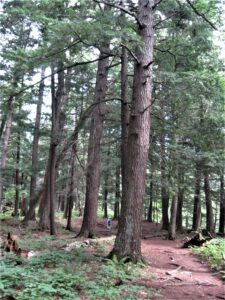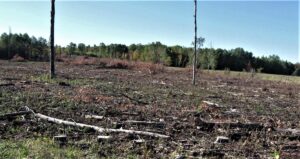Are forests only commodities?
Everywhere we go we see the scars of logging in our county and state forests. I have heard that we are seeing more logging because more of the forests are “mature” and ready to be harvested. We only think it all looks bad because for decades all those trees were left alone to grow.
But I think the county boards and the state forest managers are squeezing out every penny in a desperate effort to keep taxes low and make up for budget cuts. As Aldo Leopold once said, “We abuse land because we regard it as a commodity belonging to us.”
I wrote about this in “Wisconsin Old Growth” back in December, 2019. It needs repeating today.
Wisconsin Old Growth
“I always laugh that if we could have people lay down in the woods in a nice wind …under some big pines and just listen to that hum that goes through those trees and watch those trees sway, that the peace that would be encountered would put a lot of psychiatrists out of work.” — John Bates, naturalist and author
When you sit on shore in the Boundary Waters soaking in the solitude, or view the Milky Way on a clear night, or listen to the hum of the wind in trees a thousand years old, you know how insignificant we really are. Nature has the ability to put our petty human lives in perspective and to renew one’s spirit. My wife and I have visited some magnificent groves of virgin trees in northern Minnesota, Wisconsin, and Upper Michigan. We have seen a few of the huge old growth trees in the western U.S. and have felt the humility of being in their presence.
Only 0.3% of Wisconsin’s old-growth forests remain in scattered, small parcels. My wife and I are fortunate to live with some mature trees. It is not “old growth” as the property was clear cut in the early 20th century and then turned into farmland. But a few trees were too small for the loggers and grew to be mature size. Around 1970 the farming was abandoned. Gradually nature took its course and the forest has been coming back. Maybe, given another 100 years, it will approach the grandeur of a pre-settlement forest.
A connection with nature can have benefits beyond the aesthetic and recreational. Climate change, resource depletion, and the deliberate or unintended consequences of human behavior will impact all of us. There are many practical, economic, and scientific reasons why we need healthy forests. Old-growth forests are one of the few land uses where topsoil is created instead of destroyed. More carbon and nitrogen are retained in old-growth forests than forests of other age classes. Old growth is the best for improving water and air quality.
Richard Louv, in The Nature Principle: Reconnecting With Life in a Virtual Age, talks about how “nature deficit disorder” can affect people and re-connecting with nature is essential for individuals and society. He writes:
“Every day our relationship with nature, or lack of it, influences our lives… but in the twenty-first century, our survival – our thrival –will require… a reunion of humans with the rest of nature …a re-connection to the natural world is fundamental to human health, well being, spirit, and survival.”
John Bates, author of Our Living Ancestors: The History and Ecology of Old-growth Forests in Wisconsin And Where to Find Them, discusses the importance of old growth forests and lists the few remaining remnants in Wisconsin. In a Wisconsin Public Radio interview Mr. Bates says:
“In the 15 years that I spent researching this book, wandering all around the state, I couldn’t find one square mile of true remnant old-growth forest left in the entire state. We were that thorough in our cutting of these old forests.”
What is an old growth forest? In many ways it is not what you may think. It is not just big or old trees. Mr. Bates points out that real old forests includes trees of all ages and sizes. In an old growth forest, one quarter to one third of the trees will be young. The forest is always changing with trees blowing down, dying and being re-seeded. What is considered old varies as well. White pine can live for 400 years, but still a pine tree 100-150 years is old by our standards. Aspen is a short lived species and is very, very old at 80 years. Old-growth forests are complex ecosystems consisting of a variety of species, including hundreds of species that are not trees. The forest is messy with many fallen trees, open places, and dead, rotting wood.
It is interesting that along the Niagara Escarpment in northeastern Wisconsin there are white cedar trees that are more than 1,000 years old but only one inch in diameter. Old trees are not always big. Like the bristlecone pines out west, environmental conditions resulted in stunted development. Life is more complicated than we think.
Drive around the forests of northern Wisconsin and you will see many cut over areas. Despite the claims that we use selective cut and sustainable forestry practices, these cut over places are largely denuded. They are industrial wastelands. Our county, state and national forests, with a few small exceptions, are tree farms not forests.
We can, and should, do better. We need a broader understanding of, and appreciation for, the environment. We need to realize that we are part of nature and not its master. Nature isn’t a commodity just for our use. As Aldo Leopold said many, many years ago:
“We abuse land because we regard it as a commodity belonging to us. When we see land as a community to which we belong, we may begin to use it with love and respect.”
This is not just about our past mistakes. It is not just about the loss of the beauty and magnificence of ancient forests. It is a story of what could have been if our forefathers had been wiser and less greedy.
This is also a lesson for us today about our current problems. With many of the problems we face, there are solutions. We know there are better ways of doing things. But we don’t have the foresight, wisdom, or political will to do what is right and needed. We don’t understand that “everyone does better when everyone does better” including Mother Nature.
We can produce plenty of wood, do it profitably, and still have healthy forests. There are examples of forests managed for long term, multiple age, and old growth that prove it is possible. Next week we will look at several existing forests that promote diversity, protect old growth, and are profitable.


